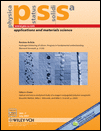Nanocrystalline MgB4O7:Dy for high dose measurement of gamma radiation
Abstract
Magnesium borate activated by dysprosium (MgB4O7:Dy) is a low-Zeff, tissue-equivalent material that is commonly used for medical dosimetry of ionizing radiations such as gamma and X-rays using the thermoluminescence (TL) technique. Nanocrystals of the same material are produced and their TL characteristics are studied. It is found that the nanocrystalline MgB4O7:Dy with a dopant concentration of 1000 ppm is the most sensitive amongst varying dopant concentrations, with its sensitivity equal to 0.025 times that of the standard phosphor CaSO4:Dy. The glow curve has two peaks at 154 °C and 221 °C. The nanophosphor has very poor sensitivity for low doses up to 10 Gy but beyond this dose the phosphor exhibits a linear response up to 5000 Gy. On increasing the dose further the response first becomes supralinear and then sublinear, finally resulting into saturation. Considering also its low fading particularly under post-irradiation annealing and excellent reusability features, this nanophosphor may be used for high dose (10–5000 Gy) measurements of ionizing radiations. (© 2007 WILEY-VCH Verlag GmbH & Co. KGaA, Weinheim)




